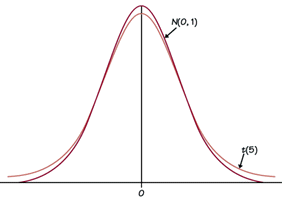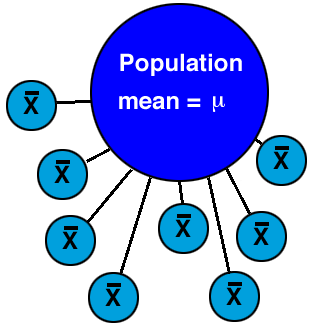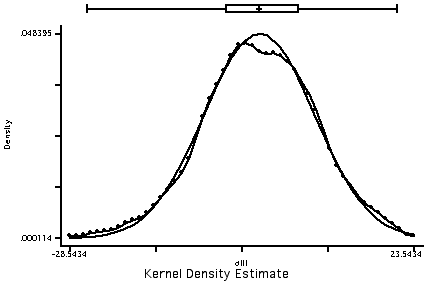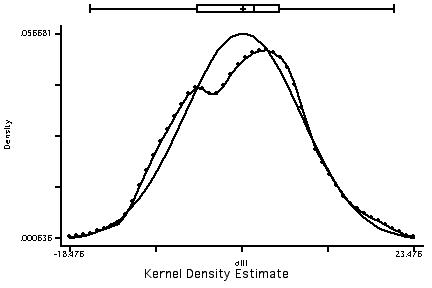


Use the Student's t Distribution.
The t-distribution is used to test groups differences when samples are small or when the population variance is unknown. The t-distribution is a family of curves that are symmetric and appear similar to the normal distribution, in fact, for extremely large samples the t and the normal distributions are identical. This is why statisticians say that the t-distribution is asymptotically normal. The t-distribution was first described by a British statistician named W.S. Gossett who worked for the Guinness Brewery in Dublin, Ireland. He published his results under the nom de plume of Student.
Each member of the family of curves in the t-distribution is a function of a parameter called the degrees of freedom. The t-distribution could be tabled in the same way that the normal distribution is, except that it would require a separate table for each of the curves. The t-distribution is tabled with several different probability levels as columns and degrees of freedom as rows. As part of the computation of the t-tests formulas, you will be given formulas the degrees of freedom.

Where  is the standard error of the mean.
is the standard error of the mean.

Is the class mean significantly different from the state mean?
First, compute the standard deviation from the variance:
s = SQRT(s2) = SQRT(121) =
11
Next, compute the standard error of the mean:
se = s/SQRT(n) = 11/SQRT(20) = 11/4.47 =
2.46
Compute the t-test:
t = (Xbar - μ)/se = (70.5 - 65)/2.46 = +2.24
The degrees of freedom, df = n -1 = 20 -1 = 19
The critical value for t at alpha = 0.05 is ±2.093
Thus, it is concluded that the class of third graders scored significantly higher than the state average.




| Control Group | Experimental Group |
|---|---|
| 102 | 107 |
| 99 | 125 |
| 90 | 111 |
| 121 | 117 |
| 114 | 122 |
Stata Examples
input group score x1
1 102 1
1 99 1
1 90 1
1 121 1
1 114 1
2 107 -1
2 125 -1
2 111 -1
2 117 -1
2 122 -1
end
ttest score, by(group)
Two-sample t test with equal variances
------------------------------------------------------------------------------
Group | Obs Mean Std. Err. Std. Dev. [95% Conf. Interval]
---------+--------------------------------------------------------------------
1 | 5 105.2 5.508176 12.31666 89.90685 120.4931
2 | 5 116.4 3.340659 7.46994 107.1248 125.6752
---------+--------------------------------------------------------------------
combined | 10 110.8 3.564641 11.27239 102.7362 118.8638
---------+--------------------------------------------------------------------
diff | -11.2 6.442049 -26.05539 3.655392
------------------------------------------------------------------------------
Degrees of freedom: 8
Ho: mean(1) - mean(2) = diff = 0
Ha: diff < 0 Ha: diff ~= 0 Ha: diff > 0
t = -1.7386 t = -1.7386 t = -1.7386
P < t = 0.0602 P > |t| = 0.1203 P > t = 0.9398
ttest score, by(group) unequal
Two-sample t test with unequal variances
------------------------------------------------------------------------------
Group | Obs Mean Std. Err. Std. Dev. [95% Conf. Interval]
---------+--------------------------------------------------------------------
1 | 5 105.2 5.508176 12.31666 89.90685 120.4931
2 | 5 116.4 3.340659 7.46994 107.1248 125.6752
---------+--------------------------------------------------------------------
combined | 10 110.8 3.564641 11.27239 102.7362 118.8638
---------+--------------------------------------------------------------------
diff | -11.2 6.442049 -26.62627 4.226274
------------------------------------------------------------------------------
Satterthwaite's degrees of freedom: 6.59196
Ho: mean(1) - mean(2) = diff = 0
Ha: diff < 0 Ha: diff ~= 0 Ha: diff > 0
t = -1.7386 t = -1.7386 t = -1.7386
P < t = 0.0642 P > |t| = 0.1283 P > t = 0.9358
use http://www.philender.com/courses/data/hsb2, clear
ttest write, by(female)
Two-sample t test with equal variances
------------------------------------------------------------------------------
Group | Obs Mean Std. Err. Std. Dev. [95% Conf. Interval]
---------+--------------------------------------------------------------------
male | 91 50.12088 1.080274 10.30516 47.97473 52.26703
female | 109 54.99083 .7790686 8.133715 53.44658 56.53507
---------+--------------------------------------------------------------------
combined | 200 52.775 .6702372 9.478586 51.45332 54.09668
---------+--------------------------------------------------------------------
diff | -4.869947 1.304191 -7.441835 -2.298059
------------------------------------------------------------------------------
Degrees of freedom: 198
Ho: mean(male) - mean(female) = diff = 0
Ha: diff < 0 Ha: diff ~= 0 Ha: diff > 0
t = -3.7341 t = -3.7341 t = -3.7341
P < t = 0.0001 P > |t| = 0.0002 P > t = 0.9999
ttest read, by(female)
Two-sample t test with equal variances
------------------------------------------------------------------------------
Group | Obs Mean Std. Err. Std. Dev. [95% Conf. Interval]
---------+--------------------------------------------------------------------
male | 91 52.82418 1.101403 10.50671 50.63605 55.0123
female | 109 51.73394 .9633659 10.05783 49.82439 53.6435
---------+--------------------------------------------------------------------
combined | 200 52.23 .7249921 10.25294 50.80035 53.65965
---------+--------------------------------------------------------------------
diff | 1.090231 1.457507 -1.783997 3.964459
------------------------------------------------------------------------------
Degrees of freedom: 198
Ho: mean(male) - mean(female) = diff = 0
Ha: diff < 0 Ha: diff ~= 0 Ha: diff > 0
t = 0.7480 t = 0.7480 t = 0.7480
P < t = 0.7723 P > |t| = 0.4553 P > t = 0.2277


Degrees of freedom: df = n - 1, where n is the number of pairs of values.
| Wives | Husbands | d |
|---|---|---|
| 107 | 102 | 5 |
| 120 | 109 | 11 |
| 100 | 111 | -11 |
| 121 | 117 | 4 |
| 116 | 121 | -5 |
| 109 | 103 | 6 |
| 120 | 111 | 9 |
| 115 | 110 | 5 |
| 117 | 109 | 8 |
| 123 | 114 | 9 |
| 108 | 109 | -1 |
| 121 | 113 | 8 |
| mean | 4 |
input wife husb
107 102
120 109
100 111
121 117
116 121
109 103
120 111
115 110
117 109
123 114
108 109
121 113
end
generate diff = wife-husb
ttest wife=husb
Paired t test
------------------------------------------------------------------------------
Variable | Obs Mean Std. Err. Std. Dev. [95% Conf. Interval]
---------+--------------------------------------------------------------------
wife | 12 114.75 2.067516 7.162085 110.1994 119.3006
husb | 12 110.75 1.523179 5.276449 107.3975 114.1025
---------+--------------------------------------------------------------------
diff | 12 4 1.882938 6.522688 -.144318 8.144318
------------------------------------------------------------------------------
Ho: mean(wife - husb) = mean(diff) = 0
Ha: mean(diff) < 0 Ha: mean(diff) != 0 Ha: mean(diff) > 0
t = 2.1243 t = 2.1243 t = 2.1243
P < t = 0.9714 P > |t| = 0.0571 P > t = 0.0286
ttest diff=0
One-sample t test
------------------------------------------------------------------------------
Variable | Obs Mean Std. Err. Std. Dev. [95% Conf. Interval]
---------+--------------------------------------------------------------------
diff | 12 4 1.882938 6.522688 -.144318 8.144318
------------------------------------------------------------------------------
Degrees of freedom: 11
Ho: mean(diff) = 0
Ha: mean < 0 Ha: mean != 0 Ha: mean > 0
t = 2.1243 t = 2.1243 t = 2.1243
P < t = 0.9714 P > |t| = 0.0571 P > t = 0.0286
use http://www.philender.com/courses/data/hsb2, clear
generate diff = write - math
ttest write = math
Paired t test
------------------------------------------------------------------------------
Variable | Obs Mean Std. Err. Std. Dev. [95% Conf. Interval]
---------+--------------------------------------------------------------------
write | 200 52.775 .6702372 9.478586 51.45332 54.09668
math | 200 52.645 .6624493 9.368448 51.33868 53.95132
---------+--------------------------------------------------------------------
diff | 200 .13 .5828931 8.243353 -1.01944 1.27944
------------------------------------------------------------------------------
Ho: mean(write - math) = mean(diff) = 0
Ha: mean(diff) < 0 Ha: mean(diff) ~= 0 Ha: mean(diff) > 0
t = 0.2230 t = 0.2230 t = 0.2230
P < t = 0.5881 P > |t| = 0.8237 P > t = 0.4119
/* check normality of difference scores */
kdbox diff, norm mean /* findit kdbox */
 ttest write = math if female==1
Paired t test
------------------------------------------------------------------------------
Variable | Obs Mean Std. Err. Std. Dev. [95% Conf. Interval]
---------+--------------------------------------------------------------------
write | 109 54.99083 .7790686 8.133715 53.44658 56.53507
math | 109 52.3945 .8765083 9.151015 50.6571 54.13189
---------+--------------------------------------------------------------------
diff | 109 2.59633 .6734012 7.030515 1.261532 3.931128
------------------------------------------------------------------------------
Ho: mean(write - math) = mean(diff) = 0
Ha: mean(diff) < 0 Ha: mean(diff) ~= 0 Ha: mean(diff) > 0
t = 3.8555 t = 3.8555 t = 3.8555
P < t = 0.9999 P > |t| = 0.0002 P > t = 0.0001
/* check normality of difference scores */
kdbox diff if female==1, norm mean
ttest write = math if female==1
Paired t test
------------------------------------------------------------------------------
Variable | Obs Mean Std. Err. Std. Dev. [95% Conf. Interval]
---------+--------------------------------------------------------------------
write | 109 54.99083 .7790686 8.133715 53.44658 56.53507
math | 109 52.3945 .8765083 9.151015 50.6571 54.13189
---------+--------------------------------------------------------------------
diff | 109 2.59633 .6734012 7.030515 1.261532 3.931128
------------------------------------------------------------------------------
Ho: mean(write - math) = mean(diff) = 0
Ha: mean(diff) < 0 Ha: mean(diff) ~= 0 Ha: mean(diff) > 0
t = 3.8555 t = 3.8555 t = 3.8555
P < t = 0.9999 P > |t| = 0.0002 P > t = 0.0001
/* check normality of difference scores */
kdbox diff if female==1, norm mean

effect size power=.8 power=.7 power=.6
small (0.2) 393 309 245
medium (0.5) 63 50 40
large (0.8) 25 20 16
very large (1.1) 13 11 9
These are just some generally suggested sample sizes to give you an idea of the range of possible
sample sizes, more precise estimates should be made for each individual study.
Intro Home Page
Phil Ender, 14Nov00